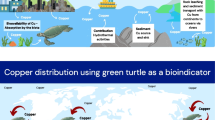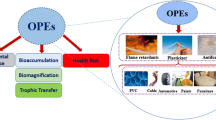Summary
The contamination of North Sea sediments with PCB (as the sum of concentrations of 24 individual components), p, p′-DDE, HCB, α-HCH and Lindane (γ-HCH) was determined in 101 samples taken in early summer 1986. The patterns of individual PCB congeners in the sediments differ between depositional areas and offshore stations: samples from the Kattegat/Skagerrak/Norwegian channel as well as the inner German Bight show higher amounts of highly chlorinated congeners than samples from the central North Sea. The geographical differences in organochlorine contamination were demonstrated on the basis of dry sediments and the content of total organic matter. Concentrations of ΣPCB, p, p′-DDE and HCB reflect the areas of recent deposition of suspended matter in the North Sea. The Ems-Dollard estuary is a source of HCB pollution to the southern North Sea, p, p′-DDE associated to suspended matter from the Baltic Sea presumably accumulates in the Kattegat/Skagerrak/Norwegian channel. Concentrations of Lindane and α-HCH showed only slight gradients or even none in the area investigated.
Zusammenfassung
Es wird über die Belastung von 101 flächendeckend beprobten Nordseesedimenten mit polychlorierten Biphenylen (24 Einzelisomere), p, p′-DDE, HCB, α-HCH und Lindan (γ-HCH) berichtet. Die PCB-Muster der im Frühsommer 1986 gezogenen Proben unterscheiden sich hinsichtlich Gebiete mit Nettosedimentation und der zentralen Nordsee: in den Mustern der Sedimente des Kattegats, des Skagerraks, der Norwegischen Rinne und der inneren Deutschen Bucht sind hochchlorierte Isomere, in der zentralen Nordsee niederchlorierte Isomere dominant. Geographische Trends in der Schadstoffbelastung werden auf der Basis des Trockengewichts, sowie normiert auf den Gehalt des Sediments an organischer Substanz aufgezeigt. Sedimente der Norwegischen Küste und der inneren Deutschen Bucht sind hoch mit PCBs, p, p′-DDE und HCB belastet. Die Ems emittiert HCB, die Ostsee p, p′-DDE in die Nordsee; Lindan und α-HCH zeigen keine ausgeprägten Gradienten.
Résumé
La contamination des sédiments de la mer du Nord avec du PCB — (somme de 24 composants différents), p, p′-DDE, HCB, α-HCH et Lindane (γ-HCH) fut déterminée dans 101 échantillons pris au début de l'été 1986. Les types de composants individuels de PCB dans les sédiments sont différents selon qu'ils proviennent de zones de déblais ou de stations offshore. Les prélèvements en provenance de Kattegat/Skagerrak/Norvegian Channel comme ceux de la baie intérieure allemande accusent des montants plus élevés de composants hautement chlorés que les prélèvements provenant du centre de la mer du Nord. Les différences géographiques dans la contamination organochlorée ont été démontrées sur la base de sédiments secs et du volume total de la matière organique. Les concentrations de ΣPCB, p, p′-DDE et HCB reflètent les zones de dépôts récents de matière suspendue dans la mer du Nord. L'estuaire Ems-Dollard est une source de pollution HCB pour la région sud de la mer du Nord; le p, p′-DDE associé aux matières suspendues en provenance de la mer Baltique s'accumule probablement dans le Kattegat/Skagerrak/Norvegian channel. Les concentrations de Lindane et de α-HCH n'ont pas montré de variation significative dans la zone étudiée.
Similar content being viewed by others
References
Ballschmiter, K. and M. Zell, 1980: Analysis of polychlorinated biphenyls (PCB) by glass capillary gas chromatography. Fresenius. Z. Anal. Chem.302, 20–31.
Basford, D. and A. Eleftheriou, 1988: The benethic environment of the North Sea (56° to 61° N). J. Mar. biol. Ass. U.K.68, 125–141.
Blumer, M., 1957: Removal of elemental sulfur from hydrocarbon fractions. Anal. Chem.29, 1039–1041.
Boon, J. P., M. B. van Zantvoort, M. J. M. A. Govaert and J. C. Duinker, 1985: Organochlorins in benthic polychaetes (Nephtys spp.) and sediments from the southern North Sea. Identification of individual PCB components. Neth. J. Sea Res.19, 93–109.
Burkhard, L. P., D. E. Armstrong and A. W. Andren, 1985: Partitioning behavior of polychlorinated biphenyls. Chemosphere14, 1703–1716.
Carter, C. W. and I. H. Suffet, 1982: Binding of DDT to dissolved humic materials. Environ. Sci. Technol.16, 735–740.
Choi, W. W. and K. Y. Chen, 1976: Associations of chlorinated hydrocarbons with fine particles and humic substances in nearshore surficial sediments. Environ. Sci. Technol.10, 782–786.
DHI, 1987: Dispersion of substances in the North Sea. Meereskd. Beob. Ergeb. Dt. Hydrogr. Inst.55, 47 pp.
Duinker, J. C. and M. T. J. Hillebrand, 1983a: Characterization of PCB components in Clophen formulations by capillary GC-MS and GC-ECD techniques. Environ. Sci. Technol.17, 449–456.
Duinker, J. C. and M. T. J. Hillebrand, 1983b: Composition of PCB Mixtures in biotic and abiotic marine compartments (Dutch Wadden Sea). Bull. Environ. Contam. Toxicol.31, 25–32.
Duinker, J. C., M. T. J. Hillebrand and J. P. Boon, 1983: Organochlorines in benthic invertebrates and sediments from the Dutch Wadden Sea: identification of individual PCB components. Neth. J. Sea Res.17, 19–38.
Duinker, J. C., J. P. Boon and M. T. J. Hillebrand, 1984: Organochlorines in the Dutsch Wadden Sea. Neth. J. Sea Res. Publ. Ser.10, 211–228.
Duinker, J. C., 1986: The role of small, low density particles on the partition of selected PCB congeners between water and suspended matter (North Sea area). Neth. J. Sea Res.20, 229–238.
Duinker, J. C., D. E. Schulz and G. Petrick, 1988: Multidimensional gas chromatography with electron capture detektion for the determination of toxic congeners in polychlorinated biphenyl mixtures. Anal. Chem.60, 478–482.
Eder, G., 1976: Polychlorinated biphenyls and compounds of the DDT group in sediments of the central North Sea and the Norwegian depression. Chemosphere5, 101–106.
Eder, G., 1984: Organische Umweltchemikalien in marinen Sedimenten. Veröff. Inst. Meeresforsch. Bremerh.20, 41–48.
Eisma, D., 1981: The mass-balance of suspended matter and associated pollutants in the North Sea. Rapp. P.-v. Réun. Cons. int. Explor. Mer181, 7–14.
Eisma, D., 1986: Flocculation and de-flocculation of suspended matter in estuaries. Neth. J. Sea Res.20, 183–199.
Eisma, D. and J. Kalf, 1987a: Dispersal, concentration and deposition of suspended matter in the North Sea. J. Geol. Society London.144, 161–178.
Eisma, D. and J. Kalf, 1987b: Distribution, organic content and particle size of suspended matter in the North Sea. Neth. J. Sea Res.21, 265–285.
Hassett, J. P. and E. Milicic, 1985: Determination of equilibrium and rate constants for binding of a polychlorinated biphenyl congener by dissolved humic substances. Environ. Sci. Technol.19, 638–643.
Hiraizumi, Y., M. Takahashi and H. Nishimura, 1979: Adsorption of polychlorinated biphenyls onto sea bed sediment, marine plankton, and other adsorbing agents. Environ. Sci. Technol.13, 580–584.
Irion, G., F. Wunderlich and E. Schwedhelm, 1987: Transport of clay minerals and anthropogenic compounds into the German Bight and the provenance of fine-grained sediments SE of Helgoland. J. Geol. Society London.144, 153–160.
Mackay, D. and B. Powers, 1987: Sorption of hydrophobic chemicals from water: a hypothesis for the mechanism of the particle concentration effect. Chemosphere16, 745–757.
Müller-Navarra, S. and E. Mittelstaedt, 1985: Schadstoffausbreitung und Schadstoffbelastung in der Nordsee. Dt. Hydrogr. Inst. Hamburg, 50 pp.
Nau-Ritter, G. M., C. F. Wurster and R. G. Rowland, 1982: Partitioning of [14C] PCB between water and particulates with various organic contents. Water Res.16, 1615–1618.
Van Weering, T. C. E., G. W. Berger and J. Kalf, 1987: Recent sediment accumulation in the Skagerrak, northeastern North Sea. Neth. J. Sea Res.21, 177–189.
Weber, W. J. Jr., T. C. Voice, M. Pirbazari, G. E. Hunt and D. M. Ulanoff, 1983: Sorption of hydrophobic compounds by sediments, soils and suspended soils. II. Sorbent evaluation studies. Water Res.17, 1443–1452.
Author information
Authors and Affiliations
Rights and permissions
About this article
Cite this article
Knickmeyer, R., Steinhart, H. The distribution of cyclic organochlorines in North Sea sediments. Deutsche Hydrographische Zeitschrift 41, 1–21 (1988). https://doi.org/10.1007/BF02308039
Received:
Accepted:
Issue Date:
DOI: https://doi.org/10.1007/BF02308039




